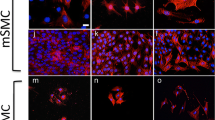Summary
Unlike skeletal and cardiac muscle cells that differentiate irreversibly, smooth muscle cells (SMCs) retain a high degree of plasticity. During the so-called phenotypic modulation, SMCs can undergo transition between a contractile phenotype and a highly proliferative synthetic phenotype, as apparent from the extinction of numerous smooth muscle (SM) markers when they are passaged in culture. It would be very usedful to have an SMC line that can be indefinitely propagated for the cellular and molecular analysis of the mechanisms that underlie the control of SM differentiation. This report describes an immortalized rabbit aorta SMC-derived cell line (U8A4) that has conserved differentiated properties through multiple subcultures. U8A4 cells can grow in the absence of serum and express the SMC markers studied, including SM α-actin, SM calponin, SM22α, SM α-tropomyosin (α-TM), SM myosin heavy chain (SM-MHC), and myocardin. U8A4 cells can activate SMC-restricted promoters like those of SM22α, SM calponin, and SM-MHC genes as efficiently as described previously for rat SMC lines (PAC1, A7r5, and A10). These cells can also process exogenous α-TM transcripts according to an SM-specific pattern. These results demonstrate that the U8A4 cell line constitutes a good alternative model to existing SMC lines that could facilitate the study of the transcriptional and posttranscriptional regulatory mechanisms underlying SMC differentiation.
Similar content being viewed by others
References
Bhalla, S. S.; Robitaille, L.; Nemer, M. Cooperative activation by GATA-4 and YY1 of the cardiac B-type natriuretic peptide promoter. J. Biol. Chem. 276:11439–11445; 2001.
Bochaton-Piallat, M. L.; Ropraz, P.; Gabbiani, F.; Gabbiani, G. Phenotypic heterogeneity of rat arterial smooth muscle cell clones. Implications for the development of experimental intimal thickening. Arterioscler. Thromb. Vasc. Biol. 16:815–820; 1996.
Camoretti-Mercado, B.; Liu, H. W.; Halayko, A. J., et al. Physiological control of smooth muscle-specific gene expression through regulated nuclear translocation of serum response factor. J. Biol. Chem. 275:30387–30393; 2000.
Casco, V. H.; Veinot, J. P.; Kuroski de Bold, M. L.; Masters, R. G.; Stevenson, M. M.; de Bold, A. J. Natriuretic peptide system gene expression in human coronary arteries. J. Histochem. Cytochem. 50:799–809; 2002.
Chen, J.; Kitchen, C. M.; Streb, J. W.; Miano, J. M. Myocardin: a component of a molecular switch for smooth muscle differentiation. J. Mol. Cell. Cardiol. 34:1345–1356; 2002.
Dulin, N. O.; Orlov, S. N.; Kitchen, C. M.; Voyno-Yasenetskaya, T. A.; Miano, J. M. G-protein-coupled-receptor activation of the smooth muscle calponin gene. Biochem. J. 357:587–592; 2001.
Firulli, A. B.; Han, D.; Kelly-Roloff, L.; Koteliansky, V. E.; Schwartz, S. M.; Olson, E. N.; Miano, J. M. A comparative molecular analysis of four rat smooth muscle cell lines. In Vitro Cell. Dev. Biol. 34A:217–226; 1998.
Gaillard, C.; Thézé, N.; Hardy, S.; Allo, M. R.; Ferrasson, E.; Thiébaud, P. α-Tropomyosin gene expression in Xenopus laevis: differential promoter usage and controlled expression by myogenic factors. Dev. Genes. Evol. 207:435–445; 1998.
Gimona, M.; Watakabe, A.; Helfman, D. M. Specificity of dimer formation in tropomyosins: influence of alternatively spliced exons on homodimer and heterodimer assembly. Proc. Natl. Acad. Sci. USA 92:9776–9780; 1995.
Gooding, C.; Roberts, G. C.; Moreau, G.; Nadal-Ginard, B.; Smith, C. W. Smooth muscle-specific switching of alpha-tropomyosin mutually exclusive exon selection by specific inhibition of the strong default exon. EMBO J. 13:3861–3872; 1994.
Kashiwada, K.; Nishida, W.; Hayashi, K., et al. Coordinate expression of alpha-tropomyosin and caldesmon isoforms in association with phenotypic modulation of smooth muscle cells. J. Biol. Chem. 272;15396–15404; 1997.
Kumar, M. S.; Owens, G. K. Combinatorial control of smooth muscle-specific gene expression. Arterioscler. Thromb. Vasc. Biol. 23:737–747; 2003.
Lees-Miller, J. P.; Helfman, D. M. The molecular basis for tropomyosin isoform diversity. Bioessays 13:429–437; 1991.
Li, L.; Miano, J. M.; Mercer, B.; Olson, E. N. Expression of the SM22alpha promoter in transgenic mice provides evidence for distinct transcriptional regulatory programs in vascular and visceral smooth muscle cells. J. Cell Biol. 132:849–859; 1996.
Miano, J. M. Mammalian smooth muscle differentiation: origins, markers and transcriptional control. Results Probl. Cell Differ. 38:39–59; 2002.
Miano, J. M.; Carlson, M. J.; Spencer, J. A.; Misra, R. P. Serum response factor-dependent regulation of the smooth muscle calponin gene. J. Biol. Chem. 275:9814–9822; 2000.
Olson, E. N. MyoD family: a paradigm for development. Genes Dev. 4:1454–1461; 1990.
Owens, G. K. Regulation of differentiation of vascular smooth muscle cells. Physiol. Rev. 75:487–517; 1995.
Pinçon-Raymond, M.; Vicart, P.; Bois, P., et al. Conditional immortalization of normal and dysgenic mouse muscle cells by the SV40 large T antigen under the vimentin promoter control. Dev. Biol. 148:517–528; 1991.
Smith, C. W.; Nadal-Ginard, B. Mutually exclusive splicing of alpha-tropomyosin exons enforced by an unusual lariat branch point location: implications for constitutive splicing. Cell 56:749–758; 1989.
Sobue, K.; Hayashi, K.; Nishida, W. Expressional regulation of smooth muscle cell-specific genes in association with phenotypic modulation. Mol. Cell Biochem. 190:105–118; 1999.
Wang, D.; Chang, P. S.; Wang, Z.; Sutherland, L.; Richardson, J. A.; Small, E. Krieg, P. A.; Olson, E. N. Activation of cardiac gene expression by myocardin, a transcriptional cofactor for serum response factor. Cell 105:851–862; 2001.
Yoshida, T.; Sinha, S.; Dandre, F., et al. Myocardin is a key regulator of CArG-dependent transcription of multiple smooth muscle marker genes. Circ. Res. 92:856–864; 2003.
Author information
Authors and Affiliations
Corresponding author
Rights and permissions
About this article
Cite this article
Pasquet, S., Thiebaud, P., Faucheux, C. et al. Characterization of a mammalian smooth muscle cell line that has retained transcriptional and posttranscriptional potencies. In Vitro Cell.Dev.Biol.-Animal 40, 133–137 (2004). https://doi.org/10.1290/1543-706X(2004)40<133:COAMSM>2.0.CO;2
Received:
Accepted:
Issue Date:
DOI: https://doi.org/10.1290/1543-706X(2004)40<133:COAMSM>2.0.CO;2




